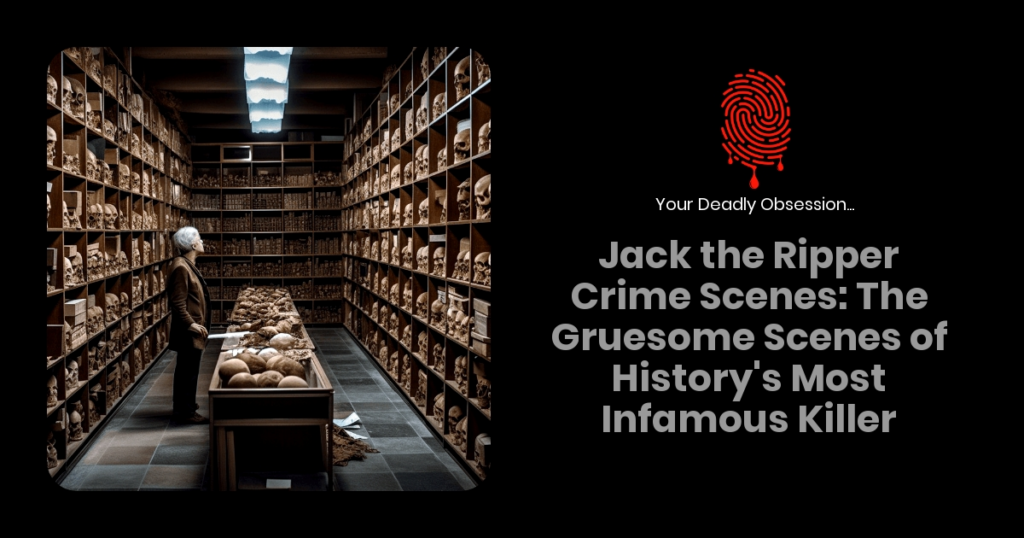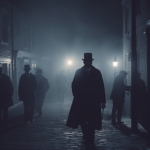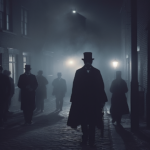No matter the time that goes by, Jack the Ripper remains a figure that continues to intrigue and captivate the imaginations of many. As we delve into the crime scenes associated with this infamous serial killer, we reveal chilling details about the cases that shook the city of London in the late 1800s. From the gruesome mutilations of the victims to the baffling clues left behind, the enigma of Jack the Ripper continues to haunt many.

In order to better comprehend the events that unfolded, it’s important to examine the locations where these grisly crimes occurred. These scenes, spread across the Whitechapel district, offer a glimpse into the grim realities faced by the women it targeted. By scrutinizing these sites, we hope to better understand the MO of the killer and possibly uncover patterns that might offer a clearer picture of his identity and motives.
We’ll be retracing the steps of this elusive criminal and attempting to piece together an image of a time steeped in darkness, fear, and unsolved mysteries. Through the exploration of the PERPLEXING crime scenes associated with Jack the Ripper, we hope to shed light on the enigmatic figure who left a chilling legacy and a string of UNRESOLVED cases that still bewilder us today.
Unveiling Jack the Ripper’s Dark Legacy
Jack the Ripper’s reign of terror sent shockwaves through London in 1888. We’re delving into the gruesome details and exploring the crime scenes that mark his sinister legacy. Over time, experts have attempted to unravel the mystery surrounding this infamous murderer. To better understand the reach of his dark legacy, we’ll examine some key elements and revisit the ghastly crime scenes.
It’s well known that Jack the Ripper terrorized the Whitechapel district, where he left a gruesome trail in his wake. Among his grim legacy:
- Five murder victims were attributed directly to Jack the Ripper
- The victims were typically impoverished women working as prostitutes
- All victims had their throats slashed, and there were instances of mutilations
The chilling string of murders took place between August and November 1888. Let’s look a bit closer at some of these notorious crime scenes:
- Mary Ann Nichols (Aug 31): Jack the Ripper’s first canonical victim was discovered in Buck’s Row, which is now called Durward Street.
- Annie Chapman (Sep 8): Found in the backyard of 29 Hanbury Street, her abdomen was brutally mutilated.
- Elizabeth Stride and Catherine Eddowes (Sep 30): Known as the “double event,” their bodies were discovered at separate locations: Stride in Dutfield’s Yard off of Berner Street, and Eddowes in Mitre Square. Both showed Jack the Ripper’s signature mutilations.
- Mary Jane Kelly (Nov 9): Found in her room on 13 Miller’s Court, Kelly’s murder was the most gruesome, with her entire body mutilated beyond recognition.
Though numerous theories have surfaced over the years as to Jack the Ripper’s identity, the case remains unsolved. This enduring mystery continues to captivate the imagination of crime and mystery enthusiasts worldwide. His sinister legacy has inspired numerous books, films, and television programs.
Aside from the horror he inflicted upon his victims, Jack the Ripper’s impact on the criminal justice system cannot be ignored. The widely-publicized murders forced the London Metropolitan Police to undergo significant reforms. This led to the establishment of the first-ever Criminal Investigation Department (CID)to combat the growing crime rate in the city.
By examining the chilling legacy of Jack the Ripper and his crime scenes, we gain a deeper understanding of the lasting impact of his dark deeds on both the victims and the wider society.
The Whitechapel Murders: A Haunting Walkthrough
It’s no secret that Jack the Ripper has captured the imagination of millions over the past century. The gruesome nature of his crimes and the fact that they remain unsolved, have made the Whitechapel Murders a gripping story for cold case enthusiasts. Let’s dive into a haunting walkthrough of the Jack the Ripper crime scenes that continue to send shivers down our spines.
To better understand the chilling nature of these crimes, it’s important to look at the context of Victorian-era Whitechapel. The area was known for its poverty and overcrowded living conditions that gave rise to high levels of violence, crime, and vulnerability among its residents. It’s within these desperate circumstances that Jack the Ripper hunted.
Between August and November 1888, Jack the Ripper claimed the lives of at least five victims. Known as the Canonical Five, these women shared similar mutilations and partial dismemberments, suggesting that these horrific attacks were the work of the same individual. The victims were:
- Mary Ann Nichols
- Annie Chapman
- Elizabeth Stride
- Catherine Eddowes
- Mary Jane Kelly
The crime scenes painted a terrifying picture, with the killer skillfully targeting women who were out on the streets late at night. He would often slit their throats before savagely mutilating their bodies. In some cases, the victims’ organs were even removed, leading some to speculate that the killer had surgical knowledge.
Many of the crime scenes were located close to each other, hinting at a potential “comfort zone” for the murderer. Some of these locales included Hanbury Street, where Annie Chapman’s lifeless body was found, and Dorset Street, where the last known victim, Mary Jane Kelly, met her gruesome end.
Despite a massive manhunt launched in response to the killings, Jack the Ripper managed to evade capture. Over time, countless theories and suspects have been proposed, yet conclusive evidence identifying the true killer remains elusive.
As we explore the haunting confines of Whitechapel during the Ripper’s reign of terror, we are reminded of the chilling impact that unsolved crimes can leave on generations of curious minds. The infamous Jack the Ripper crime scenes undoubtedly continue to serve as a dark source of inspiration for mystery enthusiasts and historians alike.
Suspects and Clues Left Behind
We’ve delved into Jack the Ripper’s gruesome crime scenes in our previous sections. Now, let’s uncover the suspects and any clues the infamous killer may have left behind.
As cold case enthusiasts, we know that Jack the Ripper has fascinated mystery lovers for over a century. In the late 1800s, the search for the killer yielded numerous suspects. Among them were:
- Montague John Druitt, a doctor who committed suicide shortly following the last murder.
- Severin Klosowski, also known as George Chapman, who was later convicted and executed for poisoning his wives.
- Aaron Kosminski, a local barber with a history of mental instability.
These are just a few of the many suspects investigated at the time. However, none of these allegations were ever decisively proven.
Throughout the investigation, thousands of clues emerged. One key piece of evidence from Jack the Ripper’s crime scenes was the letters allegedly written by the killer himself. Some of these chilling notes include the widely known “From Hell” letter and the “Dear Boss” letters. Their authenticity, though, still remains a point of debate among experts.
Another important clue is the autopsy reports from the victims, which highlight the similarities in the killings. Key findings in these reports involve the victims’ throats being slashed and the removal of certain organs. In at least one case, the organs were found missing from the crime scene altogether. This has led some to believe that the killer might’ve possessed surgical or anatomical knowledge, further complicating the profile of potential suspects.
A common detective practice during investigations is to collect fingerprints and footwear impressions at crime scenes. However, forensic technology back then was not as advanced as it is today. This limitation could have largely contributed to the unsolved status of the case.
In the table below, we summarize the suspicions surrounding the case for easy reference:
| Key Clue | Description |
|---|---|
| Letters | Allegedly written by the killer; authenticity debated |
| Autopsy Reports | Disclose similarities between victims; suggest anatomical knowledge |
| Fingerprints | Forensic analysis is limited by technology |
No solid conclusion exists regarding “who” Jack the Ripper may have been, and the enigma of Suspects and Clues Left Behind continues to draw mystery-lovers in. Admittedly, we may never be able to TRULY unmask the notorious killer. Nonetheless, we’ll keep searching, learning, and discussing the fascinating and gruesome story of Jack the Ripper.
Gruesome Discoveries: Examining the Crime Scenes
When it comes to discussing Jack the Ripper crime scenes, we can’t help but delve into the gruesome and sinister details. As die-hard fans of cold cases, crime, and mystery, it’s essential to analyze the five main crime scenes attributed to this infamous serial killer. Let’s examine the chilling locations where his victims were found, including the timelines and specific areas in which these ghastly events occurred.
The Canonical Five victims of Jack the Ripper all had one thing in common: they were brutally murdered in the East End of London, specifically in the Whitechapel district. The killings happened in the following chronological order:
- Mary Ann Nichols – August 31, 1888
- Annie Chapman – September 8, 1888
- Elizabeth Stride – September 30, 1888
- Catherine Eddowes – September 30, 1888
- Mary Jane Kelly – November 9, 1888
Their bodies were found in the following locations:
- Mary Ann Nichols: Bucks Row (now Durward Street)
- Annie Chapman: Hanbury Street, no. 29
- Elizabeth Stride: Dutfield’s Yard, off Berner Street (now Henriques Street)
- Catherine Eddowes: Mitre Square
- Mary Jane Kelly: Inside a room at Miller’s Court, off Dorset Street
These crime scenes bore horrifying marks of rage and brutality. The victims were often discovered with their throats slashed, their abdomens mutilated, and in some cases, with organs removed. We’ll give you a glimpse of what investigators encountered at these ghastly scenes.
- Nichols: Her throat was slashed twice, deep enough to nearly sever her head from her body. She also had her abdomen cut open and several incisions.
- Chapman: Both her throat and abdomen were slashed, with intestines removed and draped over her right shoulder. Her uterus, along with parts of her bladder and vagina, were missing.
- Stride: She was discovered with a single slash to her throat, her body still warm, leading to speculations that the killer might have been interrupted.
- Eddowes: Her throat was deeply gashed, with her face mutilated and her abdomen opened. A portion of her intestines was laid over her right shoulder, and her left kidney and uterus were removed.
- Kelly: Her savagely mutilated body was laid out on the bed, with her heart missing. She was disemboweled, and her face was hacked beyond recognition.
Through these crime scenes, we gain a deeper understanding of the dark and twisted world of Jack the Ripper. Each scene has its own chilling tales of discovery, raising questions about the motives and methods of this still-unknown killer. As we continue to unearth and explore the complexities surrounding these infamous murders, the atmosphere of the late 1880s Whitechapel remains forever imprinted in the minds of true crime aficionados.

Modern Techniques Shining Light on the Case
Over the years, advances in technology and forensics have provided new information on the Jack the Ripper case. In this section, we’ll explore several modern techniques that have helped to shine light on the infamous Whitechapel murders.
DNA analysis has played a crucial role in identifying possible suspects. In 2014, a scientist named Dr. Jari Louhelainen claimed to have traced mitochondrial DNA recovered from a shawl with bloodstains belonging to one of the victims, Catherine Eddowes, to one of the most prominent suspects: Aaron Kosminski. However, debates surrounding the validity of these results and potential contamination have been a point of contention among experts.
Digital forensics, specifically geographic profiling, has also been employed to analyse the spatial pattern of the crime scenes. Through this technique, mathematician Dr. Kim Rossmo and criminologist Dr. Michael Green identified a possible geographic epicenter of the killer’s activities – placing a stronger focus on a few particular suspects, including Kosminski and Francis Tumblety.
Another valuable tool has been the historical analysis of handwriting. One letter purportedly sent by the murderer, the “Dear Boss” letter, was rigorously analyzed in a 2018 study. Experts determined that the handwriting was potentially carried by the same hand who wrote a letter detailing a gruesome double murder, leading to the possibility of a genuine communication from the killer.
Advancements in linguistic analysis have provided further insights into the identity of the killer. In 2013, a study conducted by Dr. Andrea Nini focused on the analysis of phraseology, vocabulary and grammar from the so-called “Ripper letters”. The study concluded that the most likely candidate for authorship was a man named James Maybrick – adding yet another suspect to the case.
Some modern techniques that have helped shine light on the case include:
- DNA analysis
- Geographic profiling
- Handwriting analysis
- Linguistic analysis
Despite these advances in technology and analysis, the identity of Jack the Ripper remains shrouded in mystery. With more than 100 suspects and insufficient evidence to definitively reach a conclusion, the hunt for the Whitechapel murderer continues to captivate cold case enthusiasts and crime experts alike. As new techniques and technology continue to be developed, we are hopeful that more answers may be uncovered in the future.
Who was Jack the Ripper?

Jack the Ripper was an unidentified serial killer active in the late 19th century in the Whitechapel district of London. The killer was infamous for brutally murdering and mutilating at least five female prostitutes, and despite numerous investigations, the true identity of Jack the Ripper remains a mystery.
What did Jack the Ripper do with the organs?

Jack the Ripper removed organs from some of his victims, which has led to speculation about his motives and possible medical knowledge. The fate of these organs remains unknown, but theories suggest they may have been taken as trophies or disposed of to hinder the investigation.
Conclusion: Jack the Ripper’s Enduring Mystery
Throughout our exploration of Jack the Ripper’s crime scenes, it has become evident that this enigmatic serial killer continues to captivate and perplex us. Even after more than a century since the gruesome murders took place, we’re still left with many unanswered questions. Here’s a summary of what we examined:
- The brutal killings in Whitechapel in 1888;
- The alleged letters sent by the killer;
- The mysterious circumstances surrounding his identities and motives.
Despite countless theories, books, and documentaries, finding a definitive answer to the identity of Jack the Ripper remains elusive. Several reasons contribute to the Ripper’s enduring mystery:
- The limited forensic techniques in the late 19th century;
- The vast array of suspects put forth by investigators;
- The killer’s sudden disappearance after the canonical five murders.
Furthermore, the lack of concrete evidence has given birth to numerous conspiracy theories and speculation, some of which include:
- Jack the Ripper might have been a skilled surgeon due to the nature of the mutilations;
- The Royal Family’s alleged connection to the crimes, suggesting a cover-up;
- Possible links to other unsolved murders in the United States and Germany.
Ultimately, while DNA testing and modern criminal profiling techniques have provided fresh insights into this notorious case, we might never truly uncover the full story of Jack the Ripper. Regardless, our fascination with this enigmatic killer doesn’t seem to wane, as each new angle or theory only adds to the complex layers surrounding his legend.
So, as we delve further into this ever-evolving mystery, we can’t help but ask: will we ever truly solve the chilling crimes of history’s most notorious serial killer? Only time will tell. Until then, the ghost of Jack the Ripper will continue to haunt our imaginations, epitomizing the age-old struggle between good and evil.
References:

Owner & entrepreneur with a passion for murder mystery! Seriously, who doesn’t love murder mystery?
Chris is a proud member of the American Medical Writer’s Association (AMWA), the International Society for Medical Publication Professionals (ISMPP), the National Association of Science Writers (NASW), the Council of Science Editors, the Author’s Guild, and the Editorial Freelance Association (EFA).

